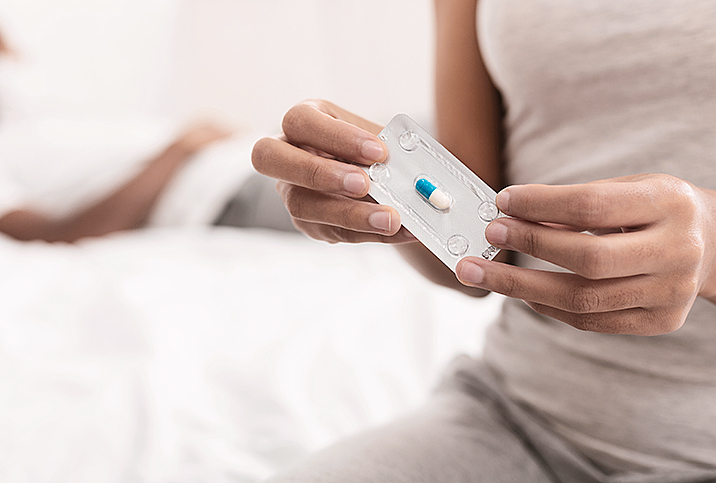Experiencing Symptoms of BPH? Here's What You Should Tell Your Doctor

Benign prostatic hyperplasia (BPH), sometimes referred to as prostate gland enlargement, is a common condition many men age 50 and older may face. It's not prostate cancer and it's not a serious health threat, but its symptomology can significantly alter a person's life on a day-to-day basis.
Some symptoms of BPH include the following:
- Increased urinary frequency
- Pain when passing urine
- Difficulty starting urine flow
- A weak or interrupted flow
- Dribbling at the end of urinary flow
- An increased need to urinate at night
- Urinary retention (inability to pass urine)
- Urinary incontinence
What's the next step if you're experiencing symptoms of BPH? What do you need to tell your doctor in order to receive the proper treatment?
What does your doctor need to know?
The first detail your physician should be made aware of is the complications you're experiencing, said S. Adam Ramin, M.D., a urologic surgeon and the medical director of Urology Cancer Specialists in Los Angeles. It can be easy to forget a symptom when you are put on the spot during an appointment, so make a list.
"There is a document called the AUA [American Urological Association] Symptom Score that patients can fill out. This will quantify the degree of lower urinary tract symptoms," Ramin explained.
Your healthcare provider may ask you to fill out this document, which inquires about aspects such as:
- How often you feel you don't empty your bladder
- How often you feel urinary urgency
- How often your urine does not flow properly
- Whether you need to push or strain when urinating
- How many times you get up during the night to pass urine
The questionnaire asks patients to keep track of these symptoms over a period of one month. It's important to take note of your experiences and answer the questions honestly to assess your symptom severity.
It's also helpful to note anything that triggers or worsens symptoms, according to Hana Patel, M.B.B.S., a general practitioner and mental health coach in London. These triggers could include caffeine, alcohol or spicy foods. Your healthcare provider will also ask about your lifestyle habits, such as diet and intake of beverages, caffeine and alcohol, and take a full family and medical history.
How can you track your symptoms?
Of the tendencies that are useful to track before seeing your healthcare provider, Ramin said the most important ones are:
- How often you pass urine in the daytime
- How often you need to urinate overnight
- How many times a day you have symptoms such as incontinence, pain, urine retention, urine urgency, leaking or the inability to empty your bladder
- Triggers that make symptoms worse
Several apps exist to help track urinary symptoms:
- proudP measures urine flow and extracts key indicators of prostate and bladder wellness.
- Bladder Pal helps you keep track of your fluid intake and urine output.
- UroBladderDiary records liquid intake and outtake, frequency, urgency and leakage (but it's only available for iPhone).
- My Bladder allows you to track your daily bladder activity and symptoms.
- Blad.dr helps you track your bladder symptoms, treatment and progress.
What else might your doctor check?
Depending on your symptoms and their severity, your healthcare provider might arrange further tests, including:
- Digital rectal exam (DRE)
- Urine analysis
- Blood tests
- Prostate-specific antigen (PSA) test
- Urinary flow test
Ramin explained that your doctor may measure prostate growth as well.
"Volumetric measurement of the prostate can be obtained by ultrasonography and/or magnetic resonance imaging [MRI]," he said.
Ultrasonography can also measure the degree of bladder muscle hypertrophy caused by BPH.
"Bladder muscle hypertrophy means thickening of the bladder muscle," Ramin said. "The more hypertrophy, the more likelihood of developing urinary incontinence, urgency and frequency of urination."
In addition, the development of urinary leakage or an urge to urinate are ominous signs.
"It is usually the late result of an untreated enlarged prostate," Ramin explained. "Prostate volume measurement, done by transrectal ultrasound, is an excellent way to determine if the prostate is getting larger over time."
Another issue clinicians can measure is the ability of some men with advanced BPH to completely empty their bladder, Ramin added. The residual amount of urine left over in the bladder after going to the bathroom is called post-void residual (PVR).
"This can also be measured by ultrasound," he explained. "Normally, all men and women have a small amount of PVR, about 1 ounce. However, with BPH, the PVR may be elevated, and eventually, BPH may lead to urinary retention."
Ultrasounds and MRI scans are noninvasive, and there's usually no prep work needed before your appointment. If you do need an ultrasound or MRI scan to assess any of these prostate problems, your healthcare provider can inform you and talk you through the procedure beforehand.
What happens after your appointment?
BPH symptoms can vary dramatically depending on the individual.
"In some men, the symptoms are mild and do not need treatment. In others, they can be very troublesome," Patel said.
If your symptoms are mild, you might decide to monitor them; for some men, symptoms can ease without any treatment. Simple lifestyle changes such as limiting caffeine and alcohol, reducing your liquid intake in the evening, and scheduling bathroom visits can be helpful.
A supplement could give a boost to your lifestyle efforts, especially one that combines three prostate-friendly herbs in one capsule. Prostate Health vitamins from Giddy Health utilize saw palmetto, stinging nettle and pygeum in a formulation meant to manage prostate size and maintain a healthy urinary flow. And its microbead technology ensures a timed release throughout the day.
Men with bothersome symptoms should undergo medical or surgical treatment, Ramin said. Once those treatment options begin, your healthcare provider should follow up regularly to determine if there have been any changes to the symptoms.
"Men with mild symptoms who prefer no treatment should also have regular follow-up appointments to determine if their symptoms are progressing to the point that requires treatment," Ramin said.
Editor's note: These statements have not been evaluated by the Food and Drug Administration. Our medical experts advise that you consult with your primary healthcare provider before you begin using a supplement. This information is not intended to diagnose, treat, cure or prevent disease.


















